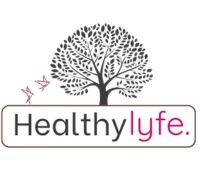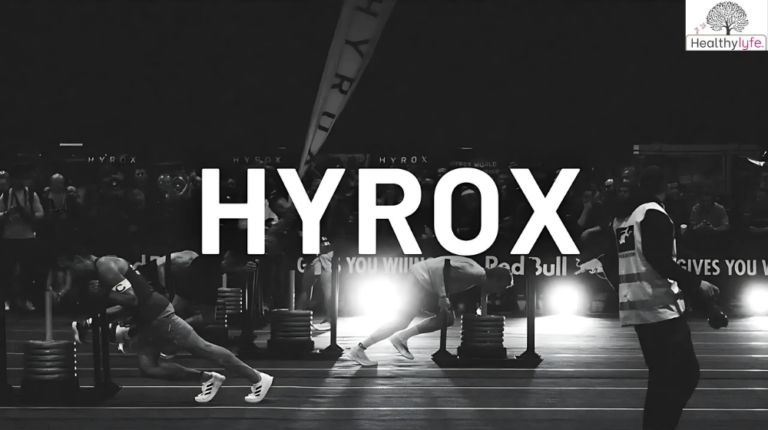Train for Hyrox Training with a comprehensive plan designed to boost strength, endurance, and mental focus. Achieve your goals and perform your best.
Introduction
Hyrox training is a functional fitness race that combines endurance, strength, and agility in a high-intensity format. As 2025 approaches, athletes and fitness enthusiasts are seeking effective ways to prepare for this challenging competition. Whether you’re a beginner or looking to refine your training, this complete guide to Hyrox training will provide you with the strategies, workouts, and insights needed to conquer your fitness goals. Get ready to elevate your performance and achieve peak physical condition.
What Is Hyrox?
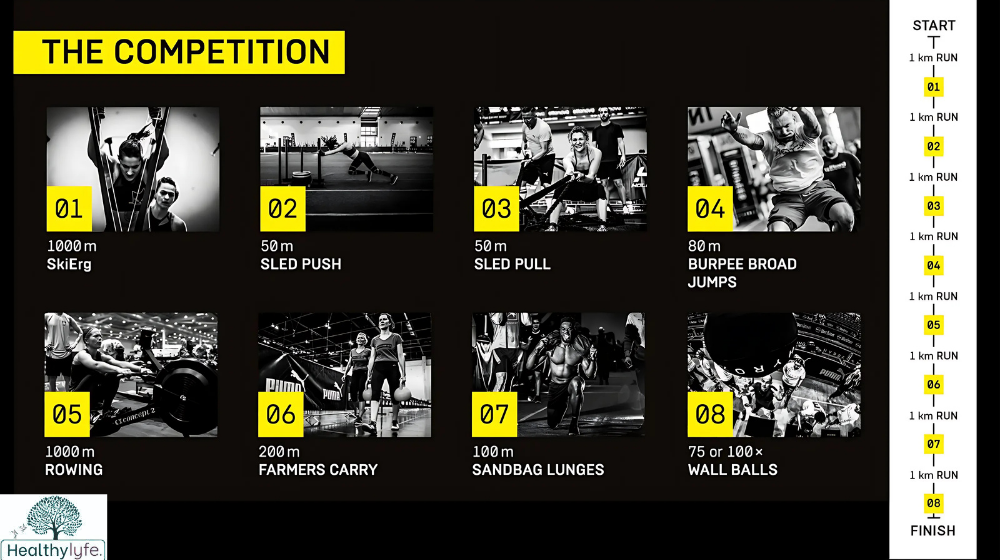
Hyrox is a unique, high-intensity fitness competition that combines elements of endurance, strength, and functional fitness. Participants complete a series of fitness challenges spread across 8 indoor stations, including exercises such as running, rowing, sled pushes, and burpees. Each station is designed to test both physical and mental stamina, making Hyrox a challenging test of overall fitness.
The event typically consists of:
- 8km run (4x2km laps)
- 1km row
- 1000m ski erg
- 100m sled push
- 100m sled pull
- 50 wall balls
- 50 burpees
- 50 deadlifts
Hyrox caters to all fitness levels, from beginners to elite athletes, with divisions based on age and ability, offering a well-rounded challenge for anyone looking to push their limits.
The Origins of Hyrox
Hyrox was created in 2017 by Dr. Christoph Ruder and Erik Wehner in Germany. They wanted to combine running with functional fitness exercises to create a unique, challenging competition. The first event was held in Hamburg and quickly gained popularity for its simple yet tough format—8km of running paired with a series of fitness stations that test both endurance and strength. Since then, Hyrox has grown into a global event, attracting fitness enthusiasts from around the world.
Why Hyrox Should Be Your 2025 Fitness Goal [1]
A Comprehensive Fitness Challenge
Hyrox is a unique fitness event that combines running with functional exercises, providing a complete test of endurance, strength, and agility. With its well-rounded approach, it offers a challenge for individuals of all fitness levels, from beginners to seasoned athletes.
Benefits of Setting Hyrox as Your Goal
- Total Body Fitness
Hyrox includes a variety of exercises like running, sled pushes, burpees, rowing, and deadlifts. This ensures that you’re working every muscle group, building strength and endurance simultaneously. - Mental and Physical Growth
The combination of physical exertion and mental focus makes Hyrox a powerful way to push your limits. Completing such a demanding event builds not only physical strength but also resilience and mental toughness. - Community and Support
One of the most rewarding aspects of Hyrox is the sense of community. You’ll join others who are equally dedicated to improving their fitness, offering support and motivation along the way. - Versatility for All Levels
Whether you’re new to fitness or a seasoned athlete, Hyrox caters to everyone. You can adapt your training to meet your current level and work towards higher goals over time.
How Hyrox Fits Into Modern Fitness Trends
Hyrox aligns perfectly with modern fitness trends by offering a balanced combination of endurance, strength, and functional movements. It focuses on functional fitness, community support, and mental toughness, creating a holistic approach to training. With divisions for all levels, it’s accessible, motivating, and tailored to meet the diverse needs of today’s fitness enthusiasts.
Getting Started With Hyrox Training
If you’re ready to take on the challenge of Hyrox, it’s important to approach your training with a structured plan. Hyrox combines running with functional fitness exercises, requiring a well-rounded approach to build endurance, strength, and mental resilience. Whether you’re a beginner or looking to improve your performance, this guide will help you get started on your journey to conquering Hyrox.
Understanding the Hyrox Workout Structure
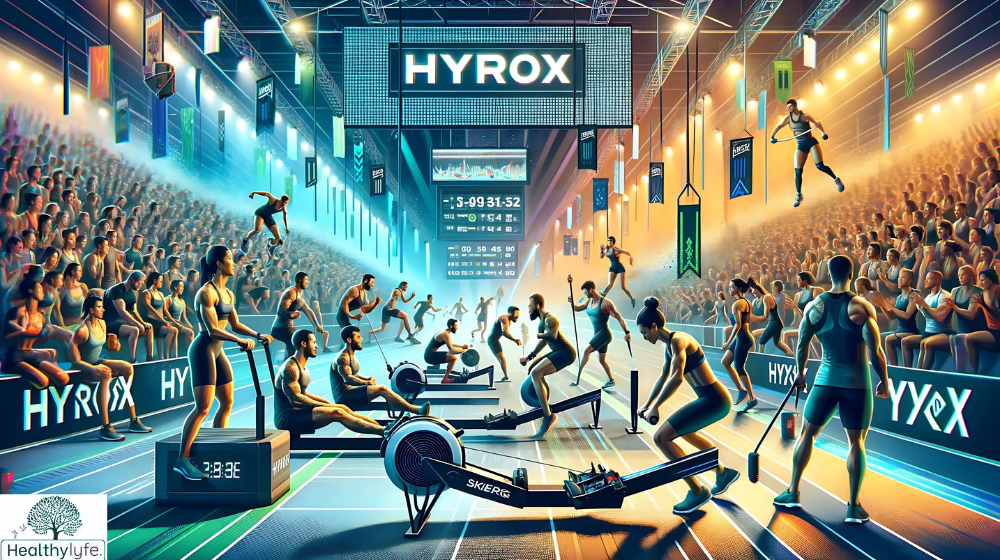
Hyrox is a unique fitness competition that combines running with functional fitness exercises in a structured format. The workout is designed to challenge both your endurance and strength, making it a well-rounded test of physical fitness. Here’s how the workout is structured:
1. The Format
- 8km Run: Divided into 4 laps of 2 kilometers each.
- 1km Row: Performed at one of the stations.
- Functional Stations: 6 different stations with exercises like sled pushes, burpees, wall balls, deadlifts, and more.
2. Station Breakdown
- Sled Push – 100m
- Sled Pull – 100m
- Row – 1000m
- Burpees – 50 reps
- Wall Balls – 50 reps
- Deadlifts – 50 reps
3. Training Focus Areas
To prepare for Hyrox, training should focus on:
- Cardiovascular Endurance: Improving your ability to run long distances.
- Strength: Building the necessary strength for exercises like deadlifts and sled pushes.
- Functional Movements: Mastering exercises that engage multiple muscle groups simultaneously.
4. Progression
Hyrox allows for progression in both volume and intensity. Beginners can start with fewer reps and shorter distances, gradually building up to full competition levels as fitness improves.
Required Equipment
To prepare for a Hyrox event, you’ll need a variety of equipment to cover both running and functional fitness exercises. Here’s what you’ll typically need:
1. Running Gear
- Running Shoes: Supportive and durable running shoes with cushioning for long distances.
- Clothing: Moisture-wicking, breathable athletic wear for comfort during the 8km run.
2. Functional Fitness Equipment
- Sled: Used for sled pushes and pulls, either at a gym or with a sled device.
- Rowing Machine: For the 1km row station.
- Wall Ball: Weighted ball for wall ball exercises.
- Dumbbells or Barbell: For deadlifts and other strength exercises.
- Kettlebells: Used for exercises like swings or burpees with kettlebell variations.
3. Other Essentials
- Resistance Bands: For assistance with functional movements.
- Jump Rope: For conditioning and cardio improvement.
- Timer/Stopwatch: To track station times and transitions.
Crafting Your Hyrox Training Plan
Preparing for a Hyrox event requires a balanced approach that includes both endurance and strength training. Below is a step-by-step guide to creating an effective Hyrox training plan.
Step 1: Set Your Goals
- Overall Goal: Complete the event, improve time, or target specific stations.
- Fitness Level: Tailor your plan based on your current fitness and areas for improvement.
Step 2: Focus on Core Elements
Your training should incorporate key components:
- Cardiovascular Endurance
- Strength Training
- Functional Movements
Step 3: Weekly Training Breakdown
| Day | Focus | Exercises | Duration |
|---|---|---|---|
| Day 1 | Long Run + Core Work | 4km run + planks, leg raises | 60 minutes |
| Day 2 | Strength Training (Upper Body) | Sled push, row, deadlifts, wall balls | 45-60 minutes |
| Day 3 | Recovery or Active Recovery | Mobility drills, light cardio | 30 minutes |
| Day 4 | Functional Circuit Training | Burpees, kettlebell swings, sled pull | 45 minutes |
| Day 5 | Long Run + Intervals | 5km run with 1-minute sprints every 1km | 60 minutes |
| Day 6 | Strength Training (Lower Body) | Sled pull, lunges, deadlifts, jump rope | 45-60 minutes |
| Day 7 | Active Recovery or Rest | Stretching, yoga, light walk | 30 minutes |
Step 4: Key Considerations
- Consistency: Stick to your training schedule, adjusting intensity and volume as needed.
- Progression: Gradually increase weights, reps, and distances to improve performance.
- Recovery: Balance intense sessions with rest and active recovery to prevent burnout.
Step 5: Monitor and Adjust
Regularly assess your progress and adjust your plan based on how you’re performing at the stations and during endurance sessions. This ensures continued improvement as you approach race day.
Tips for Excelling at Hyrox
Hyrox is a challenging event that combines endurance and functional fitness. To excel, follow these key tips:
| Tip | Description | Benefits |
|---|---|---|
| 1. Build Endurance and Strength | Gradually increase running distance and include interval training. Focus on functional strength exercises like deadlifts and sled pushes. | Improves overall fitness and performance. |
| 2. Master Functional Movements | Practice exercises like sled pulls, burpees, and rowing to improve efficiency at each station. | Enhances movement efficiency and performance. |
| 3. Prioritize Recovery | Incorporate stretching, foam rolling, and rest days to avoid injury and fatigue. | Reduces risk of injury and supports recovery. |
| 4. Train with Purpose | Create a structured training plan focusing on both strength and endurance. | Helps build specific skills for each station. |
| 5. Focus on Nutrition | Maintain a balanced diet with proper hydration and pre/post-workout nutrition. | Supports energy levels and overall performance. |
| 6. Mental Preparation | Practice mindfulness and visualization techniques during workouts. | Builds mental toughness and reduces stress. |
| 7. Optimize Transitions | Train to reduce time spent at stations by improving speed and efficiency. | Maintains momentum and improves overall time. |
| 8. Join a Community | Engage in group training or Hyrox communities for motivation and support. | Boosts morale and encourages accountability. |
Hyrox for Beginners: Overcoming Initial Challenges
Embarking on your first Hyrox journey can be an exciting yet daunting experience. With its combination of endurance, strength, and functional fitness, it’s natural to face some initial challenges. From building confidence to mastering techniques, this guide will help you navigate the early stages of your Hyrox training and set you up for success.
Common Struggles for Beginners in Hyrox
As beginners step into the world of Hyrox, they may encounter several challenges. Here are some of the most common struggles and tips to overcome them:
Building Endurance
- Challenge: Running 8km and completing high-intensity stations can feel overwhelming.
- Solution: Gradually increase your running distance and incorporate interval training to build endurance without burnout.
Mastering Functional Movements
- Challenge: Exercises like sled pushes, burpees, and deadlifts can be unfamiliar or technically challenging.
- Solution: Focus on proper form through consistent practice and seek guidance from a coach or trainer if needed.
Managing Time at Stations
- Challenge: Efficiently completing each station within the time limit can be difficult.
- Solution: Train each station separately to improve speed and technique, and work on transitions to save time.
Overcoming Mental Barriers
- Challenge: Facing a demanding workout can feel overwhelming, especially when fatigued.
- Solution: Break the event into smaller segments (e.g., completing one station at a time) to manage your mindset and reduce stress.
Balancing Training and Recovery
- Challenge: Intense training can lead to burnout or injury without proper recovery.
- Solution: Include rest days and recovery techniques like stretching, foam rolling, and active recovery to prevent overtraining.
Staying Consistent
- Challenge: Staying motivated can be difficult, especially when progress seems slow.
- Solution: Join a community or training group to stay accountable and gain motivation from others working towards similar goals.
Mental Preparation for Hyrox Races
Hyrox is not only a test of physical strength and endurance but also a mental challenge. Success in a Hyrox race requires mental toughness, focus, and the ability to push through physical fatigue. Preparing your mind is just as important as training your body. Here’s how you can build a strong mental game for race day.
Visualization Techniques for Hyrox Races
Visualization is a powerful tool for enhancing performance and building mental clarity. It helps you mentally rehearse the challenges you’ll face during a Hyrox race, making it easier to stay focused and perform at your best.
Mental Rehearsal
- What It Is: Mentally going through the entire race from start to finish.
- How to Use: Picture yourself running, completing each station, and conquering obstacles with confidence. Focus on your breathing, movements, and the positive emotions associated with success.
Control Your Breathing
- What It Is: Visualizing deep, controlled breaths to manage fatigue.
- How to Use: Picture yourself taking deep breaths during tough moments (e.g., during the sled push or burpees), allowing for mental clarity and physical ease.
Focus on Strength and Endurance
- What It Is: Imagining yourself powering through difficult stations with resilience and strength.
- How to Use: Visualize yourself completing each exercise smoothly and efficiently, reminding yourself of past successes in training sessions.
Overcoming Obstacles
- What It Is: Mentally facing and overcoming obstacles you expect to encounter, like fatigue or challenges with specific stations.
- How to Use: Create mental strategies for each obstacle, such as breaking exercises into smaller sections or using positive affirmations to push forward.
Positive Affirmations
- What It Is: Repeating positive statements during visualization to boost confidence and motivation.
- How to Use: While visualizing, reinforce statements like, “I am strong,” “I can handle this,” and “I’ve prepared for this.”
Practice Regularly
- Incorporate visualization into your training routine, especially on days when you feel mentally fatigued or unmotivated. This helps build a strong mental foundation for race day.
Building Mental Toughness
Mental toughness is a crucial component for excelling in a challenging event like Hyrox. It helps you push through physical fatigue, stay focused, and maintain a positive mindset. Here are strategies to build mental toughness:
Embrace Discomfort
- What It Is: Training your mind to handle discomfort during tough workouts and races.
- How to Build It: Gradually increase the intensity of your workouts, including longer runs, heavier lifts, and more challenging stations, to become accustomed to discomfort.
Set Small, Achievable Goals
- What It Is: Breaking down the race into smaller milestones to focus on one step at a time.
- How to Use: During training or the race, set small goals like completing one station or reaching a certain distance before taking a short mental break.
Visualization and Positive Self-Talk
- What It Is: Using visualization techniques and affirmations to reinforce confidence and focus.
- How to Use: Visualize success during tough moments and use positive affirmations like “I am capable,” “I’ve prepared for this,” to stay motivated.
Practice Mindfulness
- What It Is: Staying present in the moment to manage anxiety and fatigue.
- How to Build It: Focus on your breathing and sensations during workouts or races, helping you manage emotional and physical challenges without getting overwhelmed.
Train with Purpose
- What It Is: Structuring your training with a focus on both physical and mental demands.
- How to Use: Incorporate high-intensity interval training (HIIT), long endurance sessions, and functional movements to mimic race conditions and build mental resilience.
Recovery and Reflection
- What It Is: Ensuring proper recovery to avoid burnout and improve mental clarity.
- How to Use: After training sessions or events, reflect on what went well and where you can improve, helping you build a stronger mindset for future challenges.
Setting Realistic Goals for 2025
Setting realistic goals for 2025 is essential to stay motivated, track progress, and achieve personal milestones. Here’s how you can set achievable, yet challenging goals for the upcoming year:
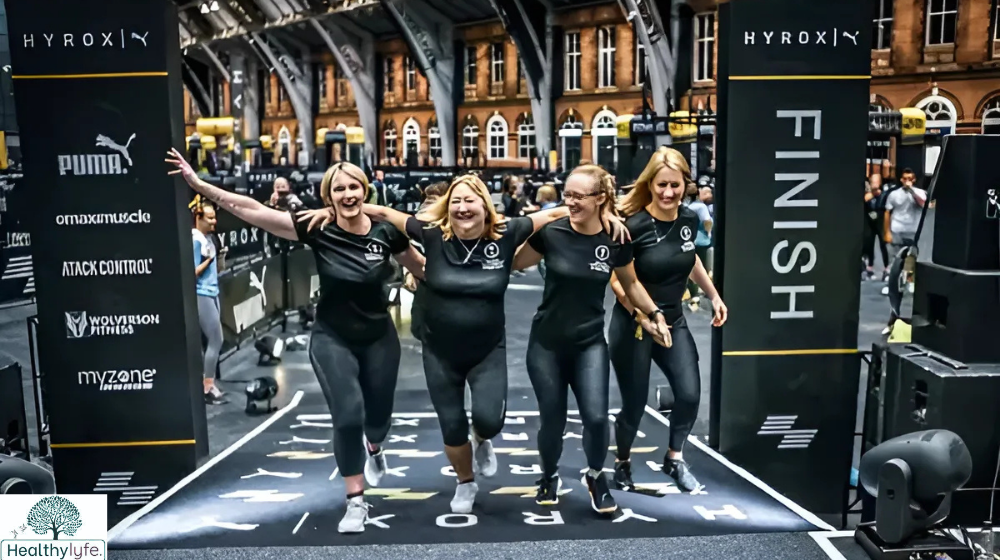
Personalized Goal-Setting
Personalized goal-setting allows you to create specific, meaningful objectives that align with your unique strengths, interests, and lifestyle. By tailoring your goals, you can stay motivated, track progress, and ensure long-term success. Here’s how to set personalized goals for 2025:
Reflect on Your Interests and Passions
Choose goals that align with activities you enjoy and are passionate about.
Example: If you love functional fitness, set a goal to participate in Hyrox or similar events, focusing on endurance and strength development.
Identify Your Strengths and Weaknesses
Focus on areas where you excel while also addressing areas for improvement.
How to Use: If running is a strength, but strength training is a weakness, set goals that balance both, such as increasing weightlifting PRs or improving running times.
Set SMART Goals
Specific, Measurable, Achievable, Relevant, and Time-bound goals ensure clarity and progress.
Example: “Complete a Hyrox event with a time under 2 hours by June 2025” is specific, measurable, and time-bound.
Break Goals into Actionable Steps
Divide your larger goal into smaller, manageable steps that are easier to achieve.
How to Use: For example, if your goal is to improve running endurance, focus on weekly mileage increases and speed intervals.
Consider Your Current Lifestyle
Set goals that fit within your current schedule and commitments to ensure consistency.
Example: If your work schedule limits gym time, set home-based training goals or prioritize shorter, more intense workouts.
Track Progress and Adjust as Needed
Continuously monitor progress and make adjustments to stay on track.
How to Use: Regular check-ins (e.g., monthly reviews) help assess whether your goals are still realistic and aligned with your progress.
Incorporate Balance
Ensure that your goals account for personal well-being, including rest and recovery.
Example: Along with physical fitness goals, set mental health goals like practicing mindfulness or reducing stress.
Seek Support and Accountability
Engage with a support system or coach to stay motivated and on track.
How to Use: Join fitness communities, participate in challenges, or work with a personal trainer to hold yourself accountable.
Tracking Progress for Personalized Goals in 2025
Tracking progress is essential for staying motivated and ensuring that you’re making steady progress toward your personalized fitness goals. Here’s how you can effectively monitor and adjust your journey:
Set Milestones
Break your larger goals into smaller milestones.
How to Use: For example, if your goal is to improve running speed, set monthly milestones like increasing your average pace or distance.
Use Metrics
Track specific metrics such as time, distance, weight, repetitions, or overall performance.
Example: Monitor your Hyrox performance, focusing on times for individual stations and total completion time.
Regular Check-Ins
Periodically evaluate your progress.
How to Use: Schedule weekly or monthly check-ins to reflect on achievements and areas for improvement.
Visualize Your Journey
Use charts, graphs, or journals to visually represent your progress.
How to Use: Track improvements over time through a fitness app or simple spreadsheets to see trends in performance.
Adjust as Needed
Make necessary adjustments to your plan based on progress.
Example: If progress slows down, reassess your training intensity or incorporate new strategies like more rest days or different exercises.
Celebrate Milestones
Acknowledge and reward progress along the way.
How to Use: Treat yourself with something rewarding (e.g., new fitness gear or a recovery day) once you reach a significant milestone.
Seek Feedback
Get input from coaches, trainers, or peers for objective assessments.
How to Use: Share progress with a fitness community or professional to gain insights and advice for continuous improvement.
Conclusion
Hyrox training is a comprehensive and challenging approach to fitness that combines strength, endurance, and mental resilience. Whether you’re a beginner or an experienced athlete, Hyrox offers a unique opportunity to push your limits, achieve personal milestones, and improve overall fitness. By setting realistic goals, incorporating structured training plans, and tracking your progress, you can prepare effectively for Hyrox events. Mental preparation and consistent effort are key to success, allowing you to embrace the journey while staying focused on your ultimate goals. With dedication and perseverance, Hyrox can transform your fitness experience and help you reach new heights in 2025 and beyond.
FAQs about Hyrox Training
What is Hyrox?
Hyrox is a global fitness race that combines running with functional fitness workouts in a standardized format.
Who can participate in Hyrox?
Anyone aged 16 and above, regardless of fitness level, can participate. There are categories for individuals, doubles, and elite athletes.
What is the standard Hyrox race format?
A Hyrox race includes 8 x 1 km runs interspersed with 8 functional workout stations, such as sled pushes, rowing, and burpee broad jumps.
How long does it take to train for a Hyrox event?
Most people need 8–12 weeks of focused training, depending on their starting fitness level.
What type of fitness is required for Hyrox?
Hyrox demands a mix of endurance, strength, power, and mental resilience.
Can beginners train for Hyrox?
Yes, with a structured plan that builds foundational endurance and functional strength, beginners can successfully prepare.
How do I structure my Hyrox training program?
A balanced plan should include running, strength training, and Hyrox-specific workouts like sled work and lunges.
How often should I train for Hyrox?
4–5 sessions per week, including both running and strength-focused days, is recommended.
What equipment is essential for Hyrox training?
Key equipment includes a sled, wall ball, rower, ski erg, and dumbbells or kettlebells.
Should I include rest days in my training?
Yes, rest and recovery are crucial to prevent burnout and optimize performance.
How important is running in Hyrox training?
Running accounts for 50% of the race, so improving your running endurance and pace is critical.
How can I improve my running speed for Hyrox?
Include interval training, tempo runs, and hill sprints in your program.
What are the most challenging Hyrox stations?
Many participants find the sled push/pull, burpee broad jumps, and wall balls the most taxing.
How do I improve my sled push and pull performance?
Focus on building lower-body and core strength with exercises like heavy squats, deadlifts, and sled drags.
How do I build endurance for burpee broad jumps?
Practice burpee intervals and focus on maintaining a steady pace.
What’s the best way to train for wall balls?
Practice sets with a wall ball that mimics race conditions, focusing on proper form and breathing.
What should I eat before a Hyrox event?
Consume a balanced meal with carbohydrates, protein, and fats 3–4 hours before the race. Stay hydrated.
How do I recover after Hyrox training sessions?
Stretch, hydrate, and eat a protein-rich meal post-workout. Prioritize sleep for recovery.
What should I wear during a Hyrox race?
Wear moisture-wicking, breathable workout gear and shoes designed for running and functional training.
How can I mentally prepare for Hyrox?
Visualize the race, break it into manageable parts, and develop a pacing strategy to stay focused.
By healthylyfe

